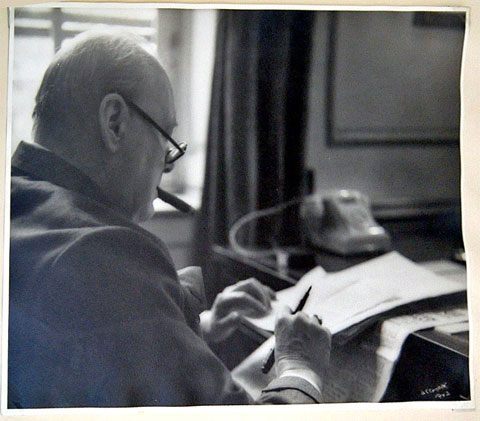The vision takes shape
- 1949: Sir Winston speaks at Massachusetts Institute of Technology, hoping for a ‘British MIT’
- 1950: Shell Petroleum memorandum for an institute of advanced technology
- 1951: Future first Master, Sir John Cockcroft, awarded Nobel Prize for splitting atom
- 1955: Sir Winston’s ‘Sicilian conversation’ with Lord Cherwell and Sir John Colville about fulfilling his hope for a ‘British MIT’; Sir Winston’s speech at Woodford on a college for advanced technology
- 1956: Colville begins to connect the Shell and Sir Winston schemes; Carl Gilbert (of Gillette) proposes an Oxbridge location
- 1957: Shell negotiation for a Birmingham location for its institute collapses; Alexander Todd proposes a Cambridge-based technological college
Churchill College was the result of two independent projects in the 1950s for the promotion of advanced technological education, which unexpectedly came to fruition in Cambridge. In 1949 Winston Churchill visited the Massachusetts Institute of Technology and expressed the hope that a similar institution could be created in Britain. While on holiday in Sicily in 1955 after his retirement as Prime Minister, he had a conversation with Lord Cherwell (Frederick Lindemann), his wartime scientific advisor, and John Colville, his secretary, in which Cherwell reminded him of his hope and urged that it was not too late to act; Colville promised to undertake the legwork.
Meanwhile, several leading British industrialists had been meeting at the London headquarters of Shell Petroleum since 1950 to discuss the need for training advanced manpower in the sciences and engineering. They proposed an independent postgraduate institute with special syllabuses, to be based at Birmingham University or Cranfield Aeronautical College (now University), but their plans ran into the sands. The American Carl Gilbert, chairman of Gillette Razor, together with the Cambridge Nobel Prizewinning chemist Alexander Todd, then recommended a Cambridge college of a special type, having a strong scientific and technological emphasis. In order to accommodate it with the University, the College would have undergraduates as well as postgraduates (postgraduate-only colleges did not exist then), and a proportion of members studying the humanities.
